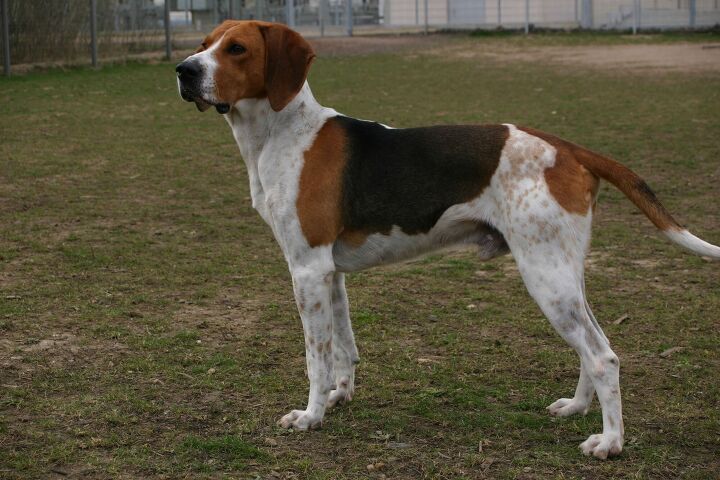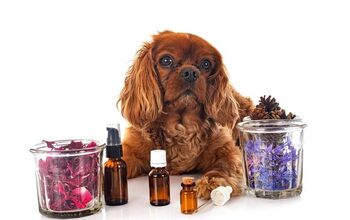Anglo-Francais De Petite Venerie


About Anglo-Francais De Petite Venerie
Upon first glance, it’s easy to tell that the Anglo-Francais de Petite Venerie is a French hound. Its medium size, tricolor coat, and muscular build are all familiar sights within the hound group. What makes this breed unique is the way it is used in hunting. Rather than hunting large game like other French hounds, this breed is used alone or in packs to drive the prey back toward the waiting hunter.
The Anglo-Francais de Petite Venerie is a medium-sized Anglo-French hound used as a scent hound to hunt in packs.
The Anglo-Francais de Petite Venerie is a medium-sized Anglo-French hound used as a scent hound to hunt in packs. This breed was created by crossing French scenthounds with English foxhounds and its name comes from the fact that it hunts small game, not from its size. What sets this hound apart from other Anglo-French hounds is the way it was used to drive game back towards the waiting hunter instead of actually hunting it down, as was the standard practice with larger French hunting hounds.
The breed is officially recognized in its country of origin but was only recognized internationally by the FCI in 1983. It is kept primarily as a hunting dog in France, though internationally is sometimes adapted as a pet. The AKC has yet to accept the breed but it is classified as a scent hound by the UKC.
The Anglo-Francais de Petite Venerie was developed from crosses of older Anglo-French hounds as well as the Harrier (also known as the Beagle) and the Poitevin. Other breeds involved in the crossing include Petit Gascon-Saintongeois and the Petit Bleu de Gascogne.
As a medium-to-large breed, the Anglo-Francais de Petite Venerie does well on a large-breed formula made with rich sources of protein and healthy fat. This breed may also do well on an active or working breed formula, given its high energy level and working life.
The Anglo-Francais de Petite Venerie is a strong-willed hunting breed developed to work with other dogs.
The Anglo-Francais de Petite Venerie is a strong-willed hunting breed developed to work with other dogs. These dogs thrive when they have a job to do and they are very active in general. In terms of training, these dogs require a firm and consistent leader as well as extensive training and socialization. They can be independent at times and easily distracted by scents, but they are not inherently dominant or aggressive by nature. These dogs do well in various hunting applications but are generally not recommended for family pets.
The Anglo-Francais de Petite Venerie is a medium-sized hunting breed that stands 16 to 21 inches tall and weighs between 35 and 45 pounds at maturity.
Generally speaking, the Anglo-Francais de Petite Venerie was never intended to be kept as a pet and is still not regarded as family-friendly. These dogs were developed specifically for hunting and their activity and pack mentality makes them a poor choice for city life and companionship. AS a breed, the Anglo-Francais de Petite Venerie is a lively, friendly, and social dog that can be very affectionate with its owner. These dogs are also easy-going around strangers and have been known to be gentle and patient with children. This breed is strong-willed, however, and does require significant training and socialization. They are not recommended for homes with small animals.
Generally speaking, the Anglo-Francais de Petite Venerie is a healthy breed with a lifespan appropriate for its breed size. As a working breed, these dogs are prone to field injuries and their large, flopped ears come with a risk for ear infections. Other conditions to which the breed may be prone include cataracts, demodectic mange, hip and elbow dysplasia, and progressive retinal atrophy.
The average lifespan for the Anglo-Francais de Petite Venerie is 12 to 15 years.
The Anglo-Francais de Petite Venerie is a highly active breed born to hunt. These dogs require a significant amount of daily exercise as well as outdoor space to run. These dogs are not recommended for indoor family life.
The Anglo-Francais de Petite Venerie was never intended to be kept as a pet and is still not regarded as family-friendly.
The Anglo-Francais de Petite Venerie is not yet accepted by the AKC but is classified as a Scenthound with the United Kennel Club and a Medium Hound with the FCI.
The Anglo-Francais de Petite Venerie is a medium breed with an athletic build and the typical hound-type coat. The coat is short-to-medium length, dense, and straight. It comes in a combination of black and white with brown or tan patches, or largely orange and white. Maintenance for the coat is fairly straightforward, requiring brushing a few times a week and more often in Spring and Fall to control seasonal shedding.
The Anglo-Francais de Petite Venerie has an average litter size of 4 to 8 puppies. As a hunting breed, early socialization and training is required. If you plan to keep this breed as a family pet, additional socialization and training may be required. Keep in mind that this breed has a high prey drive and you are unlikely to get rid of it entirely.

Kate Barrington is the loving owner of two cats (Bagel and Munchkin) and a noisy herd of guinea pigs. Having grown up with golden retrievers, Kate has a great deal of experience with dogs but labels herself a lover of all pets. Having received a Bachelor's degree in English, Kate has combined her love for pets and her passion for writing to create her own freelance writing business, specializing in the pet niche.
More by Kate Barrington

























